美国文学2 Edgar Allan Poe..
- 格式:ppt
- 大小:315.00 KB
- 文档页数:36
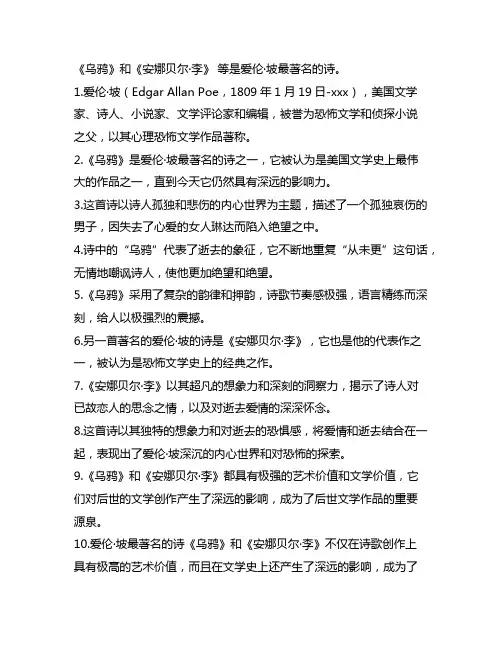
《乌鸦》和《安娜贝尔·李》等是爱伦·坡最著名的诗。
1.爱伦·坡(Edgar Allan Poe,1809年1月19日-xxx),美国文学家、诗人、小说家、文学评论家和编辑,被誉为恐怖文学和侦探小说之父,以其心理恐怖文学作品著称。
2.《乌鸦》是爱伦·坡最著名的诗之一,它被认为是美国文学史上最伟大的作品之一,直到今天它仍然具有深远的影响力。
3.这首诗以诗人孤独和悲伤的内心世界为主题,描述了一个孤独哀伤的男子,因失去了心爱的女人琳达而陷入绝望之中。
4.诗中的“乌鸦”代表了逝去的象征,它不断地重复“从未更”这句话,无情地嘲讽诗人,使他更加绝望和绝望。
5.《乌鸦》采用了复杂的韵律和押韵,诗歌节奏感极强,语言精练而深刻,给人以极强烈的震撼。
6.另一首著名的爱伦·坡的诗是《安娜贝尔·李》,它也是他的代表作之一,被认为是恐怖文学史上的经典之作。
7.《安娜贝尔·李》以其超凡的想象力和深刻的洞察力,揭示了诗人对已故恋人的思念之情,以及对逝去爱情的深深怀念。
8.这首诗以其独特的想象力和对逝去的恐惧感,将爱情和逝去结合在一起,表现出了爱伦·坡深沉的内心世界和对恐怖的探索。
9.《乌鸦》和《安娜贝尔·李》都具有极强的艺术价值和文学价值,它们对后世的文学创作产生了深远的影响,成为了后世文学作品的重要源泉。
10.爱伦·坡最著名的诗《乌鸦》和《安娜贝尔·李》不仅在诗歌创作上具有极高的艺术价值,而且在文学史上还产生了深远的影响,成为了美国文学史上的经典之作。
爱伦·坡(Edgar Allan Poe)以其独特的文学风格和对人性黑暗面的深刻洞察而闻名。
在他那短暂而不幸的一生中,他留下了许多著名的作品,其中最著名的当属《乌鸦》和《安娜贝尔·李》这两首诗。
《乌鸦》中的主人公,原本是一个愉快的年轻人,然而他的丧偶给他带来了无尽的痛苦和绝望。
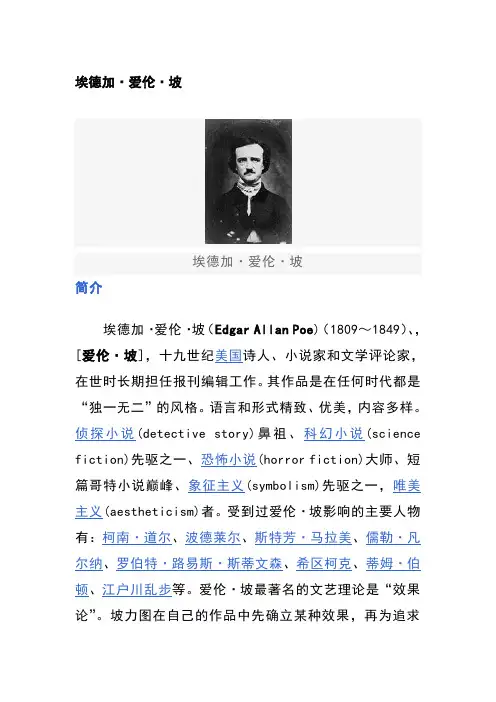
埃德加·爱伦·坡埃德加·爱伦·坡简介埃德加·爱伦·坡(Edgar Allan Poe)(1809~1849)、,[爱伦·坡],十九世纪美国诗人、小说家和文学评论家,在世时长期担任报刊编辑工作。
其作品是在任何时代都是“独一无二”的风格。
语言和形式精致、优美,内容多样。
侦探小说(detective story)鼻祖、科幻小说(science fiction)先驱之一、恐怖小说(horror fiction)大师、短篇哥特小说巅峰、象征主义(symbolism)先驱之一,唯美主义(aestheticism)者。
受到过爱伦·坡影响的主要人物有:柯南·道尔、波德莱尔、斯特芳·马拉美、儒勒·凡尔纳、罗伯特·路易斯·斯蒂文森、希区柯克、蒂姆·伯顿、江户川乱步等。
爱伦·坡最著名的文艺理论是“效果论”。
坡力图在自己的作品中先确立某种效果,再为追求这种效果而思考创作。
他在《怪异故事集》序中称“自己的作品绝大部分都是深思熟虑的苦心经营”。
爱伦·坡安布鲁斯·布尔斯(1842~1914?)和H.P洛夫克拉夫特(1890~1937)并称为美国三大恐怖小说家年表1809 1月19日生于波士顿,三兄妹中的第二个孩子,父亲戴维·坡和母亲伊丽莎白·阿诺德·坡是同一个剧团的演员。
祖籍英国的伊丽莎白·坡是一位著名的主角演员,其母伊丽莎白·史密斯·阿诺德在早期美国戏剧界也很出名。
戴维·坡的父亲出生于爱尔兰,是独立战争时期的一名爱国者,戴维·坡不久之后离家出走。
1811 母亲于12月8日在弗吉尼亚州里士满去世。
三兄妹威廉·亨利、埃德加和罗莎莉分别由三家人收养监护。
埃德加的养父母是弗朗西丝和约翰·爱伦夫妇,约翰·爱伦生于苏格兰,当时是里士满一位富裕的烟草商。
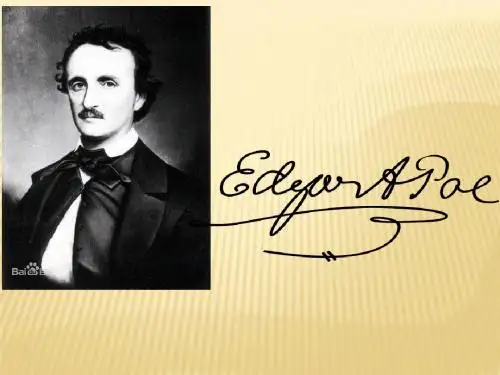
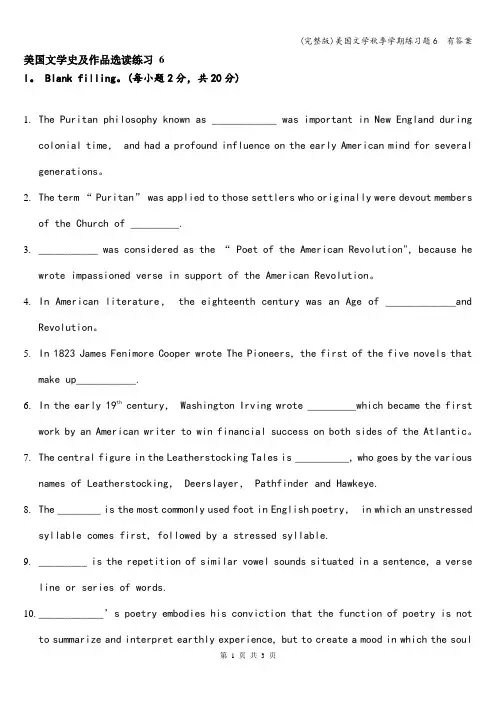
美国文学史及作品选读练习6I。
Blank filling。
(每小题2分,共20分)1.The Puritan philosophy known as ____________ was important in New England duringcolonial time, and had a profound influence on the early American mind for several generations。
2.The term “Puritan”was applied to those settlers who originally were devout membersof the Church of _________.3.___________ was considered as the “ Poet of the American Revolution", because hewrote impassioned verse in support of the American Revolution。
4.In American literature, the eighteenth century was an Age of _____________andRevolution。
5.In 1823 James Fenimore Cooper wrote The Pioneers, the first of the five novels thatmake up___________.6.In the early 19th century, Washington Irving wrote _________which became the firstwork by an American writer to win financial success on both sides of the Atlantic。
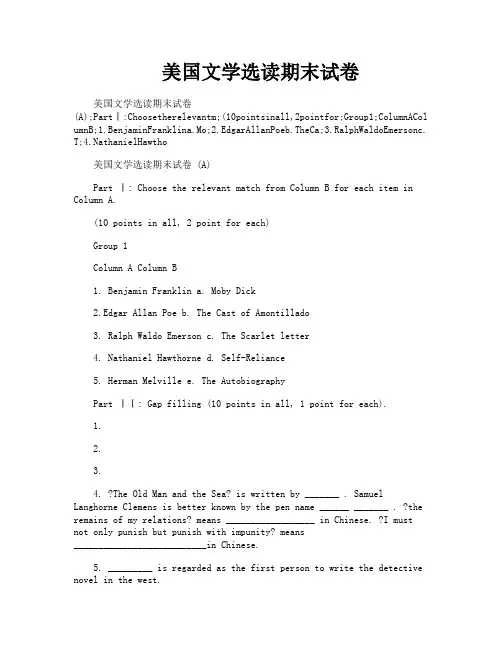
美国文学选读期末试卷美国文学选读期末试卷(A);PartⅠ:Choosetherelevantm;(10pointsinall,2pointfor;Group1;ColumnACol umnB;1.BenjaminFranklina.Mo;2.EdgarAllanPoeb.TheCa;3.RalphWaldoEmersonc. T;4.NathanielHawtho美国文学选读期末试卷 (A)Part Ⅰ: Choose the relevant match from Column B for each item in Column A.(10 points in all, 2 point for each)Group 1Column A Column B1. Benjamin Franklin a. Moby Dick2.Edgar Allan Poe b. The Cast of Amontillado3. Ralph Waldo Emerson c. The Scarlet letter4. Nathaniel Hawthorne d. Self-Reliance5. Herman Melville e. The AutobiographyPart ⅠⅠ: Gap filling (10 points in all, 1 point for each).1.2.3.4. ?The Old Man and the Sea? is written by _______ . Samuel Langhorne Clemens is better known by the pen name ______ _______ . ?the remains of my relations? means __________________ in Chinese. ?I must not only punish but punish with impunity? means___________________________in Chinese.5. _________ is regarded as the first person to write the detective novel in the west.6. Ralph Waldo Emerson is the supporter of _________.7. Herman Melville is the famous _________and poet of America.8. In 1836, a little book came out which made a tremendous impact on the intellectual life of America. It was entitled _________ by Emerson.9. The historical novel ?Scarlet Letter? describes the17th century?s life style of the___________________________ in North America.10. In Herman Melville?s Moby Dick?, as the opposite of the human being, the whale stands for __________________.Part ⅠⅠⅠ: Reading Comprehension (40 points in all, 2 points for each).AI travel a lot, and I find out different “styles” (风格) of directions every time 1 ask “How can I get to the post office?”Foreign tourists are often confused (困惑) in Japan because most streets there don?t have names; in Japan, people use landmarks (地标) in their directions instead of street names. For example, the Japanese will say to travelers, “Go straight down to the corner. Turn left at the big hotel and go past a fruit market. The post office is across from the bus stop.”In the countryside of the American Midwest, there are not usually many landmarks. There are no mountains, so the land is very flat; in many places there are no towns or buildings within miles. Instead of landmarks, people will tell you directions and distances. In Kansas or Iowa, for example, people will say, “Go north two miles. Turn east, and then go another mile.”People in Los Angeles, California, have no idea of distance on the map; they measure distance in time, not miles. “How far away is the post offi ce?” you ask. “Oh,” they answer, “it?sabout five minutes from here.” You say, “Yes, but how many miles away is it?” They don?t know. It?s true that a person doesn?t know the answer to your question sometimes. What happens in such a situation? A New Yorker might say, ?Sorry, I have no idea.” But in Yucatan, Mexico, no one answers “I don?t know.” People in Yucatan believe that “Idon?t know” is impolite, they usually give an answer, often a wrong one.A tourist can get very, very lost in Yucatan!1. When a tourist asks the Japanese the way to a certain place they usually _________A. describe the place carefullyB. show him a map of the placeC. tell him the names of the streetsD. refer to recognizable buildings and places2. What is the place where people measure distance in time?_________A. New York.B. Los Angeles.C. Kansas.D. Iowa.3. People in Yucatan may give a tourist a wrong answer ________A. in order to save timeB. as a testC. so as to be politeD. for fun4. What can we infer from the text? _________A. It?s important for travelers to understand cultural differences.B. It?s useful for travelers to know how to ask the way properly.C. People have similar understandings of politeness.D. New Yorkers are generally friendly to visitors.BHeroes of Our TimeA good heartDikembe Mutombo grew up in Africa among great poverty and disease. He came to Georgetown University on a scholarshipto study medicine ―but Coach John Thompson got a look at Dikembe and had a different idea. Dikembe became a star in the NBA, and a citizen of the United States.But he never forgot the land of his birth, or the duty to share hisfortune with others. He built a new hospital in his old hometown in the Congo. A friend has said of this good-hearted man: “Mutombo believesthat God has given him this chance to do great things.”Success and kindnessAfter her daughter was born, Julie Aigner-Clark searched for ways to share her love of music and art with her child. So she borrowed some equipment, and began filming children?s videos in her own house. The Baby Einstein Company was born, and in just five years her business grew to more than $20 million in sales. And she is using her success to help others ― producing child safety videos with John Walsh of the National Center for Missing and Exploited Children. Julie says of her new program: “I believe it?s the most important thing that I have ever done. I believe that children have the right to live in a world that is safe.”Bravery and courageA few weeks ago, Wesley Autrey was waiting at a Harlem subwaystation with his two little girls when he saw a man fall into the pathof a train. With seconds to act, Wesley jumped onto the tracks, pulled the man into the space between the rails, and held him as the train passed right above their heads. He insists he?s not a hero. He says: “We have got to show each other some love.”A. Being a star in the NBA.B. Being a student of medicine.C. His work in the church.D. His willingness to help the needy..A. helpful to his personal developmentB. something he should do for his homelandC. a chance for his friends to share his moneyD. a way of showing his respect to the NBAA. Produce safety equipment for children.B. Make videos to help protect children.C. Sell children?s music and artwork.D. Look for missing and exploited children.A. He helped a man get across the rails.B. He stopped a man from destroying the rails.C. He protected two little girls from getting hurt.D. He saved a person without considering his own safety.CTom was one of the brightest boys in the year, with supportive parents. But when he was 15 he suddenly stopped trying. He left school at 16 with only two scores for secondary school subjects. One of the reasons that made it cool for him not to care was the power of his peer group.The lack of right male role models in many of their lives ― at home and particularly in the school environment ― means that their peers are the only people they have to judge themselves against.They don?t see men succeeding in society so it doesn?t occur to them that they could make something of themselves. Without male teachers as a role model, the effect of peer actions and street culture is all powerful. Boys want to be part of a club. However, schools can provide the environment for change, and provide the right role models for them. Teachers need to be trained to stop that but not in front of a child?s peers. You have to do it one to one, because that is when you see the real child.It?s pointless sending a child home if he or she has done wrong. They see it as a welcome day off to watch television or play computer games. Instead, schools should have a special unit where a child who has done wrong goes for the day and gets advice about his problems ― somewhere he can work away from his peers and go home after the other children.A. He disliked his teachers.B. His parents no longer supported him.C. It?s cool for boys of his age not to care about studies.D. There were too many subjects in his secondary school..A. Peer groups.B. A special unit.C. The student judges.D. The home environment.A. Wait for their change patiently.B. Train leaders of their peer groups.C. Stop the development of street culture.D. Give them lessons in a separate area.12. A teacher?s work is most effective with a schoolboy when heA. is with the boy alone B. teaches the boy a lessonC. sends the boy home as punishmentD. works together with another teacherDFar from the land of Antarctica, a huge shelf of ice meets the ocean. At the underside of the shelf there lives a small fish, the Antarctic cod.For forty years scientists have been curious about that fish. How does it live where most fish would freeze to death? It must have some secret. The Antarctic is not a comfortable place to work and researchhas been slow. Now it seems we have an answer.Research was begun by cutting holes in the ice and catching the fish. Scientists studied the fish?s blood and measured its freezing point.The fish were taken from seawater that had a temperature of-1.88°C and many tiny pieces of ice floating in it. The blood of the fish didnot begin to freeze until its temperature was lowered to -2.05°C. That small difference is enough for the fish to live at the freezing temperature of the ice-salt mixture.The scientists? next research job was clear: Find out what in the fish?s blood kept it from freezing. Their search led to some really strange thing made up of a protein never before seen in put back, the blood again had its antifreeze quality and a lowered freezing point.Study showed that it is an unusual kind of protein. It has many small sugar molecules(分子)held in special positions within each big protein molecule. Because of its sugar content, it is called a glycoprotein. So it has come to be called the antifreeze fish glycoprotein, or AFGP..A. The terrible conditions in the Antarctic.B. A special fish living in freezing waters.C. The ice shelf around Antarctica.D. Protection of the Antarctic cod..A. The seawater has a temperature of -1.88°C.B. it loves to live in the ice-salt mixtureC. A special protein keeps it from freezing.D. Its blood has a temperature lower than -2.05°C.15. What does the underlined word “it” in Paragraph 5 refer to?A.A type of ice-salt mixture. B. A newly found protein.C. Fish blood.D. Sugar molecule.16. What does “glyco-” in the underlined word “glycoprotein” in the last paragraphA. sugarB. iceC. bloodD. moleculeEIf your boss asks you to work in Moscow this year, he?d better offer you more money to doso ― or even double that depending on where you live now. That?s because Moscow has just been found to be the world?s most expensive city for the second year in a row by Mercer Human Resources Consulting.Using the cost of living in New York as a base, Mercer determined Moscow is 34.4 percent more expensive including the cost of housing, transportation, food, clothing, household goods and entertainment.A two-bedroom flat in Moscow now costs $4,000 a month; a CD $24.83, and an international newspaper $6.30, according to Mercer. By comparison, a fast food meal with a hamburger is London takes the No. 2 place, up from No. 5 a year ago, thanks to higher cost of housing and a stronger British pound relative to the dollar. Mercer estimates London is 26 percent more expensive than New York these days. Following Londonclosely are Seoul and Tokyo, both of which are 22 percent more expensive than New York, while No. 5 Hong Kong is 19 percent more costly.Among North American cities, New York and Los Angeles are the most expensive and are the only two listed in the top 50 of the world?s most expensive cities. But both have fallen since last year?s study ― New York came in 15th, down from 10th place, while Los Angeles fell to 42nd from 29th place a year ago. San Francisco came in a distant third at No. 54, down 20 places from a year earlier.Toronto, meanwhile, is Canada?s most expensive city but fell 35 places to take 82nd place worldwide. In Australia, Sydney is thepriciest place to live in and No. 21 worldwide.17. What do the underlined words “a steal” in Paragraph 3 mean?_________A. an act of stealingB. something deliciousC. something very cheapD. an act of buying18. London has become the second most expensive city because of_________A. the high cost of clothingB. the stronger pound against thedollarC. its expensive transportationD. the high prices of fast food meals19. Which city is the third most expensive on the list? _________A. Tokyo.B. Hong Kong.C. Moscow.D. Sydney.20. Which city has dropped most on the list in North America?A. New York.B. Los Angeles.C. San Francisco.D. Toronto.Part IV: Translation (40 points in all, 20 points for each).1. When he found I would leave him, he took care to prevent me getting employment in anyother printing house of the town by going round and speaking to every master, who accordingly refused to give me work. I then thought of going to New York as the nearest place where there was a printer; and I was the rather inclined to leave Boston when I reflected that I had already made myself a little obnoxious to the governing party; and from the arbitrary proceeding of the Assembly in my brother?s case, it was likely I might if I stayed soon bring myself into scrapes, and further that my indiscreet disputations about religion began to make me pointed at with horror by good people as an infidel or atheist. I determined on the point, but my father now siding with my brother, I was sensible that if I attempted to go openly means would be used to prevent me.2. He had a weak point--this Fortunato--although in other regards he was a man to be[美国文学选读期末试卷]。
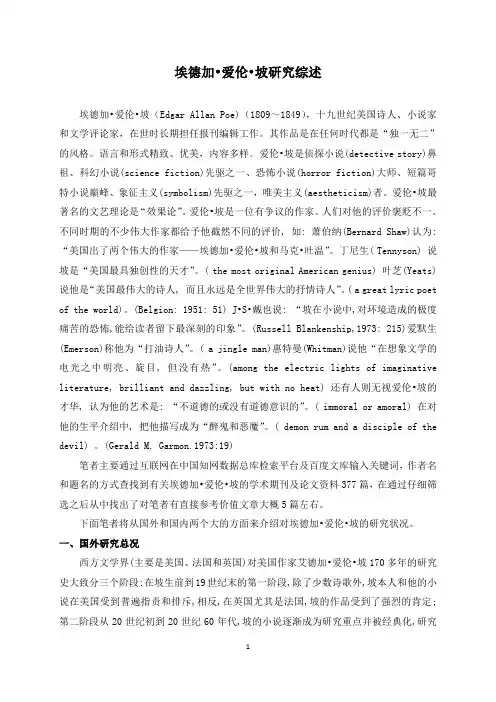
埃德加•爱伦•坡研究综述埃德加•爱伦•坡(Edgar Allan Poe)(1809~1849),十九世纪美国诗人、小说家和文学评论家,在世时长期担任报刊编辑工作。
其作品是在任何时代都是“独一无二”的风格。
语言和形式精致、优美,内容多样。
爱伦•坡是侦探小说(detective story)鼻祖、科幻小说(science fiction)先驱之一、恐怖小说(horror fiction)大师、短篇哥特小说巅峰、象征主义(symbolism)先驱之一,唯美主义(aestheticism)者。
爱伦•坡最著名的文艺理论是“效果论”。
爱伦•坡是一位有争议的作家。
人们对他的评价褒贬不一。
不同时期的不少伟大作家都给予他截然不同的评价, 如: 萧伯纳(Bernard Shaw)认为: “美国出了两个伟大的作家——埃德加•爱伦•坡和马克•吐温”。
丁尼生( Tennyson) 说坡是“美国最具独创性的天才”。
( the most original American genius) 叶芝(Yeats) 说他是“美国最伟大的诗人, 而且永远是全世界伟大的抒情诗人”。
( a great lyric poet of the world)。
(Belgion: 1951: 51) J•S•戴也说: “坡在小说中,对环境造成的极度痛苦的恐怖,能给读者留下最深刻的印象”。
(Russell Blankenship,1973: 215)爱默生(Emerson)称他为“打油诗人”。
( a jingle man)惠特曼(Whitman)说他“在想象文学的电光之中明亮、旋目, 但没有热”。
(among the electric lights of imaginative literature, brilliant and dazzling, but with no heat) 还有人则无视爱伦•坡的才华, 认为他的艺术是: “不道德的或没有道德意识的”。
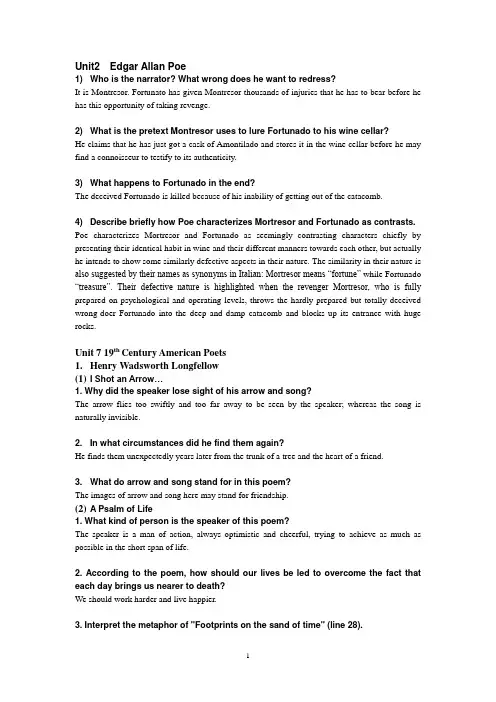
Unit2 Edgar Allan Poe1) Who is the narrator? What wrong does he want to redress?It is Montresor. Fortunato has given Montresor thousands of injuries that he has to bear before he has this opportunity of taking revenge.2) What is the pretext Montresor uses to lure Fortunado to his wine cellar?He claims that he has just got a cask of Amontilado and stores it in the wine cellar before he may find a connoisseur to testify to its authenticity.3) What happens to Fortunado in the end?The deceived Fortunado is killed because of his inability of getting out of the catacomb.4) Describe briefly how Poe characterizes Mortresor and Fortunado as contrasts. Poe characterizes Mortresor and Fortunado as seemingly contrasting characters chiefly by presenting their identical habit in wine and their different manners towards each other, but actually he intends to show some similarly defective aspects in their nature. The similarity in their nature is also suggested by their names as synonyms in Italian: Mortresor means “fortune” while Fortunado “treasure”. Their defective nature is highlighted when the revenger Mortresor, who is fully prepared on psychological and operating levels, throws the hardly prepared but totally deceived wrong-doer Fortunado into the deep and damp catacomb and blocks up its entrance with huge rocks.Unit 7 19th Century American Poets1.Henry Wadsworth Longfellow(1)I Shot an Arrow…1. Why did the speaker lose sight of his arrow and song?The arrow flies too swiftly and too far away to be seen by the speaker; whereas the song is naturally invisible.2. In what circumstances did he find them again?He finds them unexpectedly years later from the trunk of a tree and the heart of a friend.3. What do arrow and song stand for in this poem?The images of arrow and song here may stand for friendship.(2)A Psalm of Life1. What kind of person is the speaker of this poem?The speaker is a man of action, always optimistic and cheerful, trying to achieve as much as possible in the short span of life.2. According to the poem, how should our lives be led to overcome the fact that each day brings us nearer to death?We should work harder and live happier.3. Interpret the metaphor of "Footprints on the sand of time" (line 28).The metaphor refers to human deeds in real life.2. Walt Whitman(1)One's Self I Sing1. What is the significance of singing about one's self?It is an exaltation of the individual spirit, which is typical of American people.2. What is the difference between physiology and physiognomy?Physiology is a science that deals with the functions and life process of human beings, whereas physiognomy refers to an art of judging character from contours of face itself or the appearance of a person.3. What does Whitman mean by the term of "the Modern Man"?He means that a man should be free from any prejudice and pride, totally different from the traditional one, that is full of bias.(3)O Captain! My Captain!1. Why is the word "Captain" capitalized throughout the poem?In this poem the word “Captain” specially refers to Ab raham Lincoln, president of the United States.2. What overall metaphor does the poet employ in this poem?Life is a journey.3. Why do people on the shores exult and bells ring, while the speaker remains sosad?They welcome the ship returning from its hard trip, whereas the speaker is sad because the captain fails to receive his own honor.3.Emily Dickinson(1)To Make a Prairie …1. What things are needed to "make" a prairie? In what sense can one really do it? Some grass and insects and small animals. People can make a prairie with their imagination.2. How can "revery alone" create a prairie?The prairie stays in one's mind.(2) Success Is Counted Sweetest1. Why is success "counted sweetest by those who ne'er succeed"?Those who have tasted the bitterness of failure would have a keener desire for success.2. Who are "the purple host"?The so-called successful people in the world.3. Who is "he" in the last stanza?Anyone who is pursuing his success.(3) I'm Nobody!1. Who are the "pair of us" and "they" in this poem?The "pair of us" refers to the speaker in the poem and the reader, and "they" refers to the public, especially those in power.2. What does "an admiring bog" really mean?" (line 28).It Implies the vain and empty common people, who are always admiring and pursuing the celebrities.3. What is the theme of this poem?The real admirable life is a secluded and common one.4. Do you want to be "nobody" or "somebody"? Explain your reasons.Different persons would have different answers to this question. Personally, I prefer to be nobody.Unit 17 20th-Century American Poets1.Ezra PoundIn A Station of the Metro1. Why does the poet call the faces of pedestrians "apparition"?These pedestrians are all walking in a hurry amidst the drizzling rain.2. What do "petals" and "bough" stand for?Petals refer to the faces while the bough stands for the floating crowd.2. Wallace StevensAnecdote of the Jar1. What does the jar in poem symbolize? Why does the speaker place it on top of a hill?The jar here symbolizes a certain perspective on looking at this world. If the perspective of the viewing is creative and unique, it will change the conventional order of the old world. When a new perspective comes out, it will certainly hold attention from the rest.2. The jar is "round" and "of a port in air," meaning that it has a stately importance. What effect does it have on surroundings when placed on the ground?Maybe the round jar assumes the air of a domineering figure, which helps to form a certain order out of the disordered surrounding.3. How did the wilderness of Tennessee characterized? What words or phrases does the poet use to describe it?Tennessee seems to a place full of life and energy. “Slovenly,” “sprawl” and “wild” are some of the words used to describe the place. (See Anecdote of the Jar )3. William Carlos WilliamsWilliam Carlos Williams1. How does the first two lines differ from the other pairs of lines?Each of the last three couplets creates a visual image (“a red wheelbarrow,” “glaz ed with rainwater,” and “the white chickens”), whereas the first one does not.2. What is the most visually compelling word in each of the last three pairs of lines? They are “red, glazed and white”. (See EXPLANA TION: “The Red Wheelbarrow” below)3. What is the meaning of "depends upon" in the first pair of lines?The opening lines set the tone for the rest of the poem. Since the poem is composed of one sentence broken up at various intervals, it is truthful to say that 'so much depends upon' each line of the poem. This is so because the form of the poem is also its meaning. This may seem confusing, but by the end of the poem the image of the wheelbarrow is seen as the actual poem, as in a painting when one sees an image of an apple, the apple represents an actual object in reality, but since it is part of a painting the apple also becomes the actual piece of art. These lines are also important because they introduce the idea that 'so much depends upon' the wheelbarrow.SEE answer 1.4.Robert Frost(1)Fire and Ice1. What are the symbolic meanings of fire in this poem?Fire symbolizes natural disaster, human passion, as well as war.2. Why does the speaker say that ice is also great for destruction? Explain what ice stands for here.Ice, oppose to fire, is also a dreadful natural disaster in this world, and ice is always related to indifference, coldness, hatred, and the other negative sentiments of human beings.3. What is your opinion about fire and ice? Which one is more destructive?Both fire and ice can destroy this beautiful world if they are beyond control of human beings. Therefore we should be open-minded and reduce our prejudice and pride so as to keep this world in peace.(2)Stopping By Woods On a Snowy Evening1. In your opinion, what was the reason that made the speaker stop by the woods on a snowy evening?The poet was deeply attracted by the natural beauty of the scene at that very moment.2. Why did the horse give the harness bell a shake?The horse grew impatient by stopping in the middle of the dark, cold woods at midnight. It was eager to go home.3. Why couldn't the speaker stay longer by the woods to appreciate its mysterious beauty?He realized that it was late at night and he would have to hurry home to get some food and sleep,because the next morning he would have a lot of work to do.4. What is the effect of repetition in the last two lines?The refrain-like repetition in the last two lines reminds the reader a simple fact of life: whatever happens, one must go forward in the journey of his or her life.(3) The Road Not Taken1. What is the speaker's initial response to the divergence of the two roads?The speaker is at a loss which road he should choose, and he feels sorry that he cannot explore both roads at the same time.2. Describe the similarities and differences of these two roads. Which one does the speaker take?Two roads are similar except one of them is more “grassy,” which implies that it is less traveled by people. The speaker prefers the less traveled one, because he likes adventure.3. What might the two roads stand for in the speaker's mind?One road stands for the traditional one and the other is unconventional one and full of challenges and difficulties. To follow other people's footsteps or to open a new road for himself is really not an easy decision for us to make in our lives.5. Langston Hughes(1)Dreams1. Why must we stick to our dreams?If God is not the first move in our life, surely our dreams are the same.2. What images does the poet employ to describe the life once we lose our dreams? Without dreams our life will be a broken bird and a barren field. I think without dream our life will be a grand ship drifting on the vast ocean, never knowing its destination.(2)Me And The Mule1. Why does the speaker identify himself with the mule?They share a lot in their life: hard-working and full of strength, submissiveness and kindness and honesty.2. What figure of speech does the poet employ in describing the mule? Personification.。
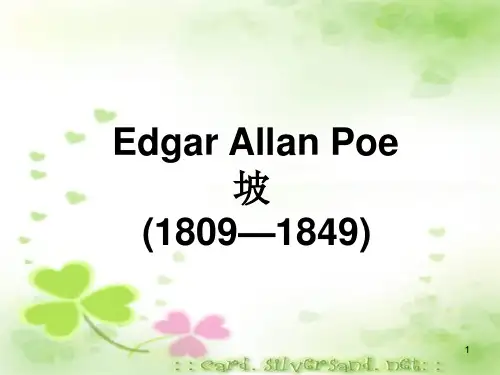
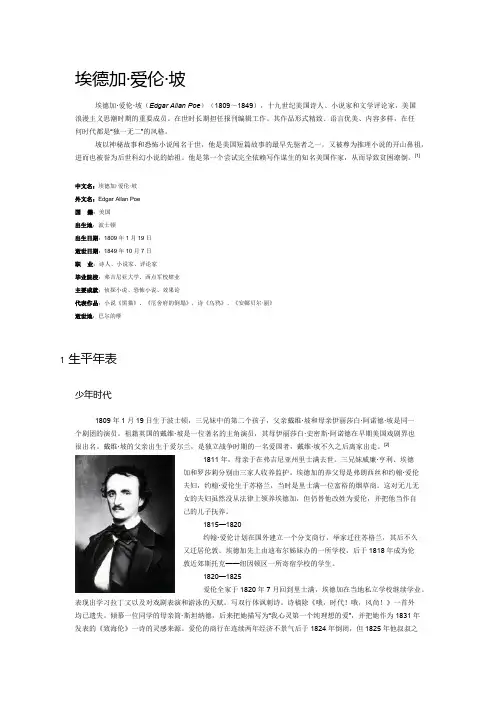
埃德加·爱伦·坡埃德加·爱伦·坡(Edgar Allan Poe)(1809~1849),十九世纪美国诗人、小说家和文学评论家,美国浪漫主义思潮时期的重要成员。
在世时长期担任报刊编辑工作。
其作品形式精致、语言优美、内容多样,在任何时代都是“独一无二”的风格。
坡以神秘故事和恐怖小说闻名于世,他是美国短篇故事的最早先驱者之一,又被尊为推理小说的开山鼻祖,进而也被誉为后世科幻小说的始祖。
他是第一个尝试完全依赖写作谋生的知名美国作家,从而导致贫困潦倒。
[1]中文名:埃德加·爱伦·坡外文名:Edgar Allan Poe国籍:美国出生地:波士顿出生日期:1809年1月19日逝世日期:1849年10月7日职业:诗人、小说家、评论家毕业院校:弗吉尼亚大学、西点军校肄业主要成就:侦探小说、恐怖小说、效果论代表作品:小说《黑猫》、《厄舍府的倒塌》,诗《乌鸦》、《安娜贝尔·丽》逝世地:巴尔的摩1 生平年表少年时代1809年1月19日生于波士顿,三兄妹中的第二个孩子,父亲戴维·坡和母亲伊丽莎白·阿诺德·坡是同一个剧团的演员。
祖籍英国的戴维·坡是一位著名的主角演员,其母伊丽莎白·史密斯·阿诺德在早期美国戏剧界也很出名。
戴维·坡的父亲出生于爱尔兰,是独立战争时期的一名爱国者,戴维·坡不久之后离家出走。
[2]1811年,母亲于在弗吉尼亚州里士满去世。
三兄妹威廉·亨利、埃德加和罗莎莉分别由三家人收养监护。
埃德加的养父母是弗朗西丝和约翰·爱伦夫妇,约翰·爱伦生于苏格兰,当时是里士满一位富裕的烟草商。
这对无儿无女的夫妇虽然没从法律上领养埃德加,但仍替他改姓为爱伦,并把他当作自己的儿子抚养。
1815—1820约翰·爱伦计划在国外建立一个分支商行,举家迁往苏格兰,其后不久又迁居伦敦。

poe写作风格摘要:1.Poe 的写作风格概述2.Poe 写作风格的特点3.Poe 写作风格的影响和启示正文:1.Poe 的写作风格概述Poe(Edgar Allan Poe,1809-1849)是美国文学史上一位极具影响力的作家,被誉为美国短篇小说的鼻祖和侦探小说的奠基人。
他的写作风格独特,具有很高的艺术价值和历史地位。
2.Poe 写作风格的特点(1)神秘主义色彩:Poe 的作品中常常充满了神秘和恐怖的氛围,这种氛围往往来自于对未知领域的探索和揭示。
Poe 善于运用神秘主义色彩来表达人类内心深处的恐惧和渴望,使读者在阅读过程中产生一种紧张和兴奋的心理状态。
(2)哥特式浪漫:Poe 的作品中常体现出哥特式浪漫的特点,如孤独、黑暗、恐怖、死亡等元素。
这些元素既反映了Poe 个人生活的不幸和内心的挣扎,也反映了当时美国社会的一些问题。
(3)心理描绘深入:Poe 在作品中对人物心理的描绘非常深入,他运用第一人称的叙述方式,详细描绘了人物内心世界的复杂和矛盾。
这使得读者能够更加真切地感受到作品中人物的情感和心理变化。
(4)语言优美:Poe 的语言简练、优美,富有音乐性和韵律感。
他善于运用各种修辞手法,如比喻、拟人、排比等,使作品具有很高的艺术价值。
3.Poe 写作风格的影响和启示Poe 的写作风格对后世产生了深远的影响,许多作家都受到他的启发,创作出了一批优秀的作品。
从Poe 的写作风格中,我们可以得到以下几点启示:(1)勇于创新:Poe 在写作中勇于尝试新的题材和形式,这使他在文学史上具有重要的地位。
我们在创作时,也应该勇于创新,不断突破自己的局限。
(2)关注人性:Poe 的作品深刻揭示了人性的复杂和矛盾,这使得他的作品具有很高的思想深度。
我们在创作时,也应该关注人性,深入挖掘人物的内心世界。
(3)注重语言艺术:Poe 的语言优美、富有韵律感,这使得他的作品具有很高的艺术价值。
我们在创作时,也应该注重语言艺术,使作品更具表现力。
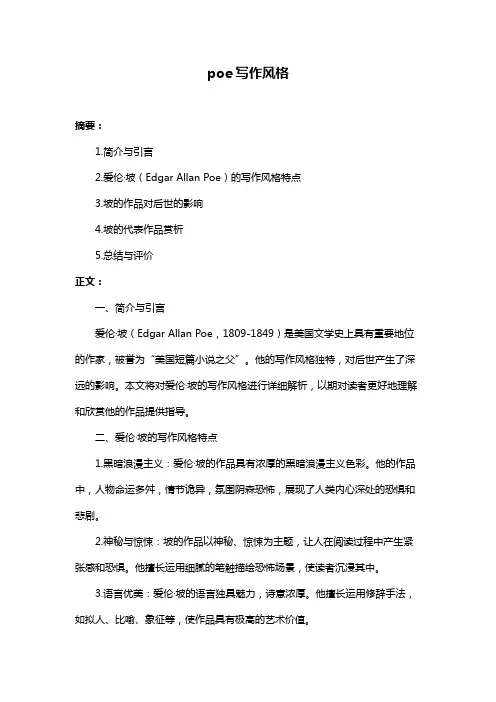
poe写作风格摘要:1.简介与引言2.爱伦·坡(Edgar Allan Poe)的写作风格特点3.坡的作品对后世的影响4.坡的代表作品赏析5.总结与评价正文:一、简介与引言爱伦·坡(Edgar Allan Poe,1809-1849)是美国文学史上具有重要地位的作家,被誉为“美国短篇小说之父”。
他的写作风格独特,对后世产生了深远的影响。
本文将对爱伦·坡的写作风格进行详细解析,以期对读者更好地理解和欣赏他的作品提供指导。
二、爱伦·坡的写作风格特点1.黑暗浪漫主义:爱伦·坡的作品具有浓厚的黑暗浪漫主义色彩。
他的作品中,人物命运多舛,情节诡异,氛围阴森恐怖,展现了人类内心深处的恐惧和悲剧。
2.神秘与惊悚:坡的作品以神秘、惊悚为主题,让人在阅读过程中产生紧张感和恐惧。
他擅长运用细腻的笔触描绘恐怖场景,使读者沉浸其中。
3.语言优美:爱伦·坡的语言独具魅力,诗意浓厚。
他擅长运用修辞手法,如拟人、比喻、象征等,使作品具有极高的艺术价值。
4.结构严谨:坡的作品结构紧凑,情节跌宕起伏。
他在构思和布局上精心设计,使作品具有强烈的逻辑性和悬念感。
三、坡的作品对后世的影响爱伦·坡的作品对后世产生了深远的影响。
他的短篇小说被誉为“现代悬疑小说的鼻祖”,对后世侦探小说、恐怖小说和科幻小说的发展产生了重要推动作用。
同时,他的诗歌作品也影响了后世的诗人,如托马斯·哈代、阿尔弗雷德·丁尼生等。
四、坡的代表作品赏析1.《破镜之谜》:这是坡的一部脍炙人口的侦探小说,讲述了一起离奇的命案。
作品情节紧凑,悬念迭起,展现了坡在推理小说领域的卓越才华。
2.《乌鸦》:这是坡的一首著名诗歌,以寓言的形式表达了作者对失去挚爱之人的悲痛和对生活的绝望。
诗歌语言优美,意境深邃,具有极高的艺术价值。
3.《鄂榭府崩溃记》:这是一部充满恐怖氛围的短篇小说,讲述了一座荒凉古堡中的诡异事件。
poe写作风格摘要:1.简介- 介绍埃德加·爱伦·坡(Edgar Allan Poe)及其写作风格2.写作风格特点- 恐怖与惊悚- 浪漫主义- 心理描绘- 短小精悍的故事结构3.代表作品分析- 《乌鸦》- 《破镜之谜》- 《陷坑与钟摆》4.影响及评价- 对后世作家的影响- 文学史上的地位与评价正文:埃德加·爱伦·坡(Edgar Allan Poe)是美国文学史上的一位杰出作家,以其独特的写作风格在文学界独树一帜。
他的写作风格特点鲜明,主要体现在恐怖与惊悚、浪漫主义、心理描绘和短小精悍的故事结构等方面。
1.恐怖与惊悚爱伦·坡的作品中充满了恐怖与惊悚的元素,他擅长运用神秘、诡异的情节和紧张的氛围来抓住读者的心。
在他的短篇小说《陷坑与钟摆》中,通过讲述一个囚犯面临严刑逼供的故事,展示了人性的黑暗面和生死存亡的抉择。
这种恐怖与惊悚的风格成为了他的一大特色。
2.浪漫主义爱伦·坡的作品具有浓厚的浪漫主义色彩。
他关注个体的情感体验,强调情感与理智的冲突。
在他的诗歌《乌鸦》中,通过描绘一只乌鸦的降临给主人公带来的绝望与痛苦,表达了人类在自然力量面前的无助与挣扎,体现了浪漫主义对个体情感的关注。
3.心理描绘爱伦·坡在作品中对人物心理进行了细腻、深入的描绘。
他关注人的潜意识、幻觉和梦境等心理现象,挖掘人性的复杂与矛盾。
在他的短篇小说《破镜之谜》中,通过讲述一个失去爱人的人试图通过催眠找回爱人记忆的故事,展示了人类心理的微妙与复杂。
4.短小精悍的故事结构爱伦·坡的故事结构紧凑、短小精悍,往往在有限的篇幅内传达出丰富的情感与思想。
他善于运用暗示、象征等手法,引导读者进行深入的思考。
这种短小精悍的故事结构使他的作品具有很高的艺术价值。
爱伦·坡的作品对后世作家产生了深远的影响,许多作家都受到了他的写作风格的启发。
allan poe to helen赏析【诗歌背景和作者简介】埃德加·爱伦·坡(Edgar Allan Poe)是美国19世纪著名的作家、诗人和文艺评论家。
他的诗歌作品以神秘、忧郁和浪漫主义风格著称,对后世美国文学产生了深远的影响。
这首《致海伦》(To Helen)是他创作于1831年的一首抒情诗,表达了诗人对美丽、优雅和纯洁的向往。
【诗歌的结构和形式】《致海伦》共分为四节,每节五行,采用抑扬格五音步(iambic pentameter)的诗歌形式。
这种形式使得诗歌在朗读时具有优美的节奏感,为诗人表达内心情感提供了恰当的载体。
诗中还运用了丰富的修辞手法,如比喻、拟人、象征等,增强了诗歌的艺术效果。
【诗歌的主题和情感】这首诗的主题是对美丽、优雅和纯洁的赞美。
诗人将海伦比喻为古希腊神话中的美丽女神,表达了对她的倾慕之情。
通过描绘海伦的眼睛、笑容和名字,诗人展示了她的魅力和神秘。
同时,诗人在诗中抒发了自己对生活的感慨,透露出一种忧郁、孤独的气质。
【诗歌的艺术价值和影响力】《致海伦》是埃德加·爱伦·坡诗歌的代表作之一,展现了诗人独特的审美观和诗歌风格。
这首诗通过对美丽女神的赞美,表达了诗人对生活的热爱和对美的追求。
同时,诗中还蕴含着一种深邃的哲理,启发读者思考生活中的美好与悲伤。
这首诗在当时和后世受到了广泛赞誉,对美国文学产生了深远的影响。
总结:通过对《致海伦》的赏析,我们可以看到埃德加·爱伦·坡作为一位杰出的诗人,以独特的艺术手法表达了自己对美丽、优雅和纯洁的向往。
这首诗不仅具有很高的艺术价值,还对后世文学产生了深远的影响。
在文学史上,爱伦·坡(Edgar Allan Poe)无疑是一个极具影响力的人物。
他不仅以其悬疑、恐怖作品而闻名,还以其诗歌作品成为文学界的瑰宝。
他的诗歌作为对人类内心深处恐惧和欲望的探索,充满了深刻的灵魂与情感。
1. 带我探讨爱伦·坡的诗歌作品在探讨爱伦·坡的诗歌作品时,我们首先不得不提到他最著名的作品《乌鸦》。
通过这首诗,坡将乌鸦的叫声和主人公的心境相结合,描绘出了一种黑暗、忧郁的氛围。
而在《安妮贝尔·李》这首诗中,他用细腻的笔触和优美的叙述,表达了对逝去爱人的思念和哀伤。
这些作品不仅在当时引起了轰动,而且至今仍广受推崇。
在整个诗歌作品中,爱伦·坡通过对恐惧、逝去、爱情等主题的探索,展现了深沉的诗意和对人类内心的洞察力。
他引领读者深入思考人生的意义和内心的矛盾,充分展现了他对文学的独特理解。
2. 总结和回顾在这篇文章中,我们对爱伦·坡的诗歌作品进行了全面的评估和探讨。
通过对其代表作的分析,我们不仅更加深入地了解了这位文学大师的作品,还对他深刻的诗意和对人类内心的探索有了更清晰的认识。
他的作品无疑对当今文学产生了重大影响,而他对恐惧、逝去、爱情等主题的诗意表达,更是给我们留下了深刻的印象。
3. 个人观点和理解在我看来,爱伦·坡的诗歌作品深刻地揭示了人类内心深处的恐惧和欲望。
他以其独特的诗意和对人生深刻的思考,成为了文学史上不可或缺的重要人物。
他的作品不仅是文学的瑰宝,更是对人类内心的深刻剖析。
通过阅读他的作品,我们不仅能领略到他细腻的诗意,更能从中获得对人生、对内心的启迪和理解。
通过本篇文章的撰写,我更加深入地了解了爱伦·坡的诗歌作品,对他的文学成就有了更为全面、深刻和灵活的理解。
希望本文也能帮助你更好地领略爱伦·坡的诗意之美。
爱伦·坡(Edgar Allan Poe)是19世纪美国文学史上的一位重要人物,他的诗歌作品以其独特的风格和深刻的主题而闻名。
1.Benjamin Franklin(本杰明.富兰克林)代表作:<自传>The Autobiography<格言历书>Poor Richard’s Almanac2.Edgar Allan Poe (埃德加.爱伦.坡)代表诗歌:<帖木尔〉“Tamerlane and Other Poems”<艾尔.阿拉夫〉“Al Araaf”<乌鸦及其他诗篇〉“The Raven and Other Poems”<致海伦〉 “To Helen”Poe’s poetic theories1,The poem should be short, readable at one sitting2, Its chief aim is beauty, namely, to produce a feeling of beauty in the reader.3, “the death of a beautiful woman is, unquestionably, the most poetical topic in the world.”4, Poe is opposed to “the heresy of the didactic” and calls for “pure” poetry 5, Poe stresses rhythm, and declares that “music is the perfection of the soul, or idea, of poetry.”短篇小说:《厄舍大厦的倒塌>“The Fall of the House of Usher”<阿芒提拉多的酒桶〉“The Cask of Amontillado”3.Emerson 爱默生代表作:<论自然〉Nature宣扬超验主义代言人哲学《论美国学者》“The American Scholar”地位:文学界独立宣言《神学院致辞》“The Divinity School Address”4.Hawthorne 霍桑代表作:《红字》 The Scarlet Letter<带有七个尖角阁的房子〉The House of the Seven Gables<玉石雕像〉The Marble Faun5.Melville梅尔维尔代表作:《白鲸》Moby Dick《玛地》Mardi《白外衣》White Jacket6.Thoreau梭罗代表作:《沃尔登》Walden《论公民的不服从》“On the Duty of Civil Disobedience”<马萨诸塞州的奴隶制〉“Slavery in Massachusetts”7 whiteman:沃尔特惠特曼free verse【Free verse】 is a form of poetry that refrains from consistent meter patterns, rhyme, or any other musical pattern.Some poets have explained that free verse, despite its freedom, must still display some elements of form. Most free verse, for example, self-evidently continues to observe a convention of the poetic line in some sense, at least in written representations, thus retaining a potential degree of linkage, however nebulous, with more traditional forms. Donald Hall goes as far as to say that "the form of free verse is as binding and as liberating as the form of a rondeau."[1] and T. S. Eliot wrote, "No verse is free for the man who wants to do a good job."[2]Some poets have considered free verse restrictive in its own way. In 1922 Robert Bridges voiced his reservations in the essay 'Humdrum and Harum-Scarum.' Robert Frost later remarked that writing free verse was like "playing tennis without a net".; Leaves of Grasmain works: “Leaves of Gras”草叶集“One’s Self I Sing”我歌唱自我“O Captain!My Captain”噢,船长,我的船长在草叶集中采用自由诗的诗歌形式,完全冲破了传统诗歌的限制,既没有诗行长短的规定也无对应的押韵,诗歌的节拍是按照日常说话的自然节奏,变化无常,出神入化,充满了个性。